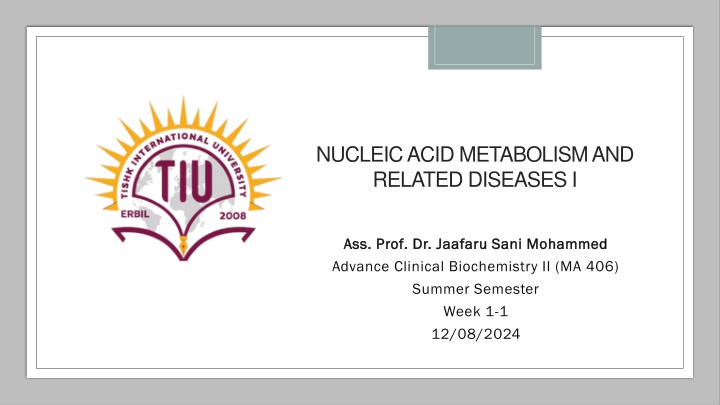
Nucleic Acid Metabolism and Related Diseases
Delve into the principles of purine metabolism, exploring the significance of nucleic acids, nitrogenous bases, and macromolecules in biochemistry, for a comprehensive understanding of genetic material and biological function.
Download Presentation

Please find below an Image/Link to download the presentation.
The content on the website is provided AS IS for your information and personal use only. It may not be sold, licensed, or shared on other websites without obtaining consent from the author. If you encounter any issues during the download, it is possible that the publisher has removed the file from their server.
You are allowed to download the files provided on this website for personal or commercial use, subject to the condition that they are used lawfully. All files are the property of their respective owners.
The content on the website is provided AS IS for your information and personal use only. It may not be sold, licensed, or shared on other websites without obtaining consent from the author.
E N D
Presentation Transcript
NUCLEIC ACID METABOLISM AND RELATED DISEASES I Ass. Prof. Dr. Jaafaru Sani Mohammed Ass. Prof. Dr. Jaafaru Sani Mohammed Advance Clinical Biochemistry II (MA 406) Summer Semester Week 1-1 12/08/2024
oNucleic Acid metabolism and associated diseases oBiochemistry of the nervous system and cerebrospinal fluid oEnzymes in clinical diagnosis oCancer Biochemistry (malignancy and tumor markers) oBiochemistry in pregnancy and antenatal screening oBiochemistry in pediatrics and in elderly persons oBiochemistry of aging and related diseases
Objectives At the end of this lesson, the students should be able to: Understand the underline principle of purine metabolism Familiarize themselves with the terminology involves Make sense of the molecules at different levels. Understand the biomedical importance of purine metabolism.
Nucleic acid oDNA: A polynucleotide primary genetic material of all cells, consisting of a poly sugar-phosphate backbone with purine and pyrimidine bases. oRNA: A polynucleotide that is unique among biological macromolecules in that it can encode genetic information and serve as an abundant structural component of cells.
oThe large molecules required for life. oBuilt from smaller organic molecules. oThere are four major biological macromolecules. oTogether, these molecules form most of a cell's mass.
Nitrogenous bases oPurines and pyrimidines are heterocyclic aromatic compounds. oThey form an important component of nucleotide when combined with sugar and phosphate groups. oPurines include adenine and guanine, while pyrimidines include thymine (DNA), uracil (RNA), and cytosine in both.
Cont. oPurine: Adenine (A) & Guanine (G) oPyrimidine: Thymine (T), Uracil (U), & Cytosine (C) oOther minor bases: Hypoxanthine & Xanthine oNucleosides: 2 components (Base + Sugar): A nitrogenous base: (Adenine, guanine, thymine, or cytosine) + Pentose sugar (Deoxyribose) in DNA. A nitrogenous base: (Adenine, guanine, cytosine or uracil) + Pentose sugar (Ribose) in RNA
Cont. oA beta-N-glycosidic bond links the carbon one of the pentose sugar and N9 of a purine or N1 of a pyrimidine (e.g., A, G, C, T, U, & I). oNucleotides: 3 main components: A nitrogenous base, Pentose sugar & Phosphate groups. oThese molecules form the DNA backbone (e.g., AMP, GMP, CMP) o> 1 phosphate groups: Esterification of the phosphate groups forms the corresponding nucleoside diphosphates and triphosphates (e.g., ATP & ADP.
NucleoSide: base + Sugar NucleoTide: base + sugar + phosphaTe
Biomedical importance nucleotides oThe main functions of nucleotides: Form the building blocks of nucleic acids. oAct as co-substrates and coenzymes in biochemical reactions Involved in cell signaling pathways. oAlso act as intracellular second messengers. oProvide chemical energy in the form of nucleoside triphosphates such as ATP.
Purines Degradation Purine nucleotides are degraded through a pathway in which they lose their phosphate by the action of 5-nucleotidase to produce adenosine. Adenosine is deaminated to inosine by adenosine deaminase, and inosine is hydrolyzed to hypoxanthine (its purine base) and D-ribose by nucleosidase. Hypoxanthine is further oxidized to xanthine and then uric acid by xanthine oxidase. Molecular oxygen is the electron acceptor in this complex reaction.
Excretion of purine products Uric acid is the excreted product of purine catabolism in primates, birds, and some other animals. A healthy adult human excretes uric acid at a rate of about 0.6 g/24 h. The excreted product arises in part from ingested purines and in part from the turnover of the purine nucleotides. In most mammals and many other vertebrates, uric acid is further degraded to allantoin by the action of urate oxidase. In other organisms the pathway is further extended to urea and ammonium.
Class activities oDescribe the term Nucleic Acid with examples oDifferentiate between Nucleotide and Nucleoside with clear examples oOutline the biomedical importance of nucleotide oEnumerate the byproducts of purine degradation. oWhich of the byproducts above is excreted by humans?
References Luch, A. ed., 2012. Molecular, clinical and environmental toxicology: volume 3: Environmental toxicology (Vol. 101). Springer Science & Business Media. Barile, F.A., 2010. Clinical Toxicology. Principles and Mechanisms. New York, Informa Healthcare, 467. Plumlee, K., 2003. Clinical Veterinary Toxicology-E-Book. Elsevier Health Sciences.

















